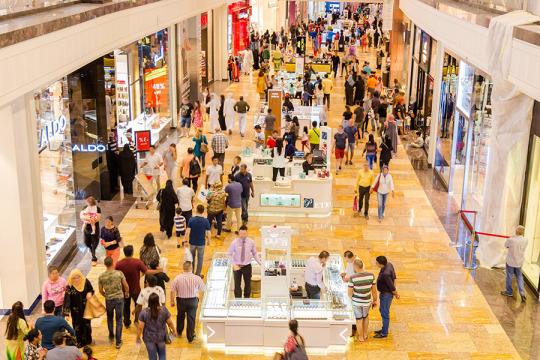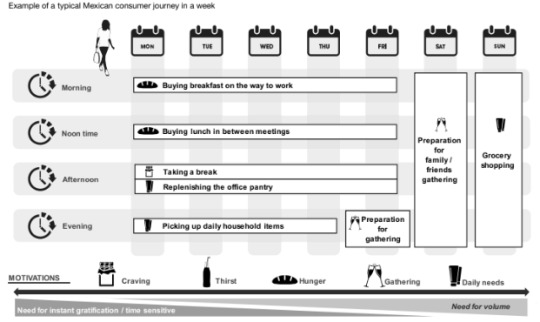#mexicanconsumers hashtag
Explore tagged Tumblr posts
Text
Evolution of Retail Consumers in Mexico
Written By: Gargi Sarma

Success in today's dynamic retail environment depends critically on recognizing and meeting customers' changing demands and preferences. This is particularly true in Mexico's dynamic market, where urbanization, shifting demographics, and changes in consumer behavior are transforming the retail industry.
The growing need for convenience is one of the major themes influencing consumer behavior in Mexico. Convenience is given top priority when making purchases by modern consumers due to their hectic schedules and high standards. Time is becoming more and more of a limited resource, which is driven by several causes such as urbanization, longer working hours, and the development of dual-income households.

Figure 1: Online Acceleration in Mexico, 2022 (Source: McKinsey & Company)
In contrast to pre-pandemic levels, online sales of books and consumer electronics rose significantly in Mexico, and despite flat global demand, a wide range of consumer products showed a shift in sales to e-commerce platforms as a result of the pandemic (Figure 1).
Market Dynamics:
The Mexican convenience store market is expected to grow at a CAGR of 5.4% from 2022 to 2027. This growth is being driven by several factors, including the increasing urbanization of the Mexican population, the rising disposable incomes of Mexican consumers, and the growing popularity of convenience shopping.
The new Mexican consumer is younger, more tech-savvy, and more demanding than previous generations. They are looking for convenient shopping experiences that are tailored to their needs and preferences.
Retailers need to adopt new business models to cater to the new Mexican consumer. This includes offering a wider variety of products and services, providing more convenient shopping options, and using technology to personalize the shopping experience.
Knowing Consumer Values: Two Mexicos, One Growing Middle Class
Mexico's Duality: A clear image of economic and social inequality is painted by the idea of two Mexicos: one established and formal, and the other less developed and informal. A growing middle class made up of customers from both sides, who individually cling to their values while looking for goods and services that speak to them, is the unifying factor within this complex terrain.
Recognizing the Principles: Although the story of "Two Mexicos" depicts general economic realities, it's important to keep in mind that customers within each category are not monolithic groups. The middle class has a wide range of complex and varied values and goals.
From Mexico's Developed States:
Aspiration for modernity: Customers look for cutting-edge technology and fashionable, well-known brands worldwide.
Appreciate quality and experience: They place a high priority on upscale goods, practicality, and individualized care.
Awareness of one's well-being and health: Eco-friendly, sustainable, and organic products are popular.

Figure 2: Example of A Typical Mexican Consumer Journey in a Week (Source: PwC)
From Mexico informally:
Value for money: Practicality and affordability should be prioritized, along with budget consciousness.;
Community and trust are important Strong relationships are formed between known stores and local brands.
Entrepreneurial spirit: Do-it-yourself projects and resourcefulness are highly valued.
Filling the Void: Comprehending these distinctions in values is imperative for companies targeting the expanding middle class. Effective tactics will not only copy models from "Mexico," but instead provide a range of goods and services: Appeal to premium and cost-conscious markets.
Adopt omnichannel tactics: For ease of use and accessibility, integrate physical and online experiences.
Bring new ideas to the local market: Adjust international patterns to suit local tastes and circumstances.
Establish community and trust: Join forces with nearby companies and participate in neighborhood projects.
The New Mexican Consumer:
Tech-savvy and mobile: This group is comfortable using online tools for shopping, research, and payments. They expect seamless omnichannel experiences.
Time-pressed: Juggling work, family, and social commitments, they value convenience and speed. They're more likely to make smaller, frequent purchases than large, infrequent ones.
Value-conscious: They seek quality products at affordable prices. Private-label brands and value packs can be appealing.
Digitally connected: They rely on social media and online reviews for information and recommendations. Building a strong online presence is crucial.
Mexican Consumers Look to E-commerce for Better Prices:
Mexican consumers, particularly younger generations, are increasingly turning to e-commerce for their shopping needs, driven by the allure of better prices. This trend is fueled by several factors, including rising inflation, growing internet access, and the convenience of mobile shopping. Platforms like Mercado Libre and Amazon are attracting new users seeking deals and wider product selection compared to traditional brick-and-mortar stores. While brand loyalty remains important, price sensitivity is driving the shift, with savvy shoppers comparing prices across platforms before making a purchase. This trend presents both challenges and opportunities for businesses, requiring them to adapt their online strategies to offer competitive pricing, seamless buying experiences, and robust logistics networks to meet the expectations of the evolving Mexican consumer.

Figure 3: Top Reasons For Buying Food and Household Supplies Online, Mexico (2023)
In Figure 3, according to the McKinsey Survey, the results between the pre-COVID-19 pandemic and early 2023, it was revealed that although it is no longer the primary means of purchase for Mexican consumers as it was during the pandemic, online shopping nevertheless accounts for a larger portion of purchases than it did before the outbreak: 17 percent of respondents say they shop online for most or all of their purchases, up from 15 percent of prepandemic respondents. Customers claim that the main reason they shop online is the price: they can locate more affordable goods, take advantage of larger discounts, and quickly compare costs across various merchants. Online purchasing is convenient for them as well. However, they do have some reservations about online shopping. These reservations stem from the potential for defective or damaged goods to arrive, mismatches between what is advertised online and what is received, and expensive delivery or shipping costs.

Figure 4: Share of Respondents Reporting That They Buy Products Online Most of the Time Or Always, By Category, Mexico (2023)
According to the McKinsey Survey (Figure 4), the results between the pre-COVID-19 pandemic and early 2023, it was revealed that the mentioned categories saw the largest movement away from traditional brick-and-mortar stores and toward online shopping: cosmetics, consumer electronics, and toys and infant supplies. These tendencies have a resemblance to e-commerce patterns observed in developed markets.
Going Beyond Division:
It's critical to keep in mind that distinctions between the "two Mexicos" are becoming more hazy. As consumers become more knowledgeable and connected, hybrid values—which combine old sensibilities with modern aspirations—become more prevalent.
Through identification of this dynamic and comprehension of the varied values held by the emerging middle class, companies can seize enormous prospects inside the Mexican market.
Prioritizing ease in their goods and strategies is crucial for merchants hoping to win over the attention and allegiance of the new Mexican consumer. The following are some crucial tactics that retailers should use:
Optimized Store Formats: To improve customer convenience, retailers can rethink their store layouts. To make shopping more efficient, this involves placing products in strategic locations, having clear signage, and having a simple navigation system. Convenience can be further improved by providing options like click-and-collect or in-store pickup for online orders.
E-commerce and Delivery Services: E-commerce is expanding quickly in Mexico as a result of the country's rising smartphone and internet connectivity rates. By making investments in reliable online platforms and effective delivery services, retailers may profit from this trend. Options for same-day or next-day delivery can greatly increase convenience for customers who would rather purchase from home.
Localized Assortments: By ensuring that customers can locate the items they need without having to search far, localized product assortments can increase convenience by taking into account regional preferences. In order to appeal to various customer segments, merchants provide a variety of payment choices as part of their specialized approach.
Technology Integration: You may improve convenience and expedite the shopping process by utilizing technology, such as digital loyalty programs, self-checkout kiosks, and mobile apps. Mobile apps, for example, can save users time and effort by offering tailored suggestions, instant inventory updates, and easy payment processes.
Convenient Payment Solutions: Offering digital wallets, installment plans, and contactless payment choices can streamline the payment process, reducing friction at the point of sale and improving customer convenience. Additionally, loyalty programs that offer discounts for regular purchases might encourage recurring business.
Emphasis on Accessibility: Providing a really easy shopping experience requires ensuring accessibility for all customers, especially those with special needs or disabilities. This entails taking into account things like wheelchair accessibility, unambiguous signage, and assistance services to let clients successfully explore the store.
Conclusion:
In summary, convenience is now a need for merchants hoping to succeed in Mexico's cutthroat market rather than merely a nice-to-have. Through the implementation of tactics that cater to the needs of the New Mexican Consumer and a focus on convenience, businesses may foster customer loyalty, increase customer happiness, and ultimately thrive in the dynamic retail industry.
About RapidPricer
RapidPricer helps automate pricing and promotions for retailers. The company has capabilities in retail pricing, artificial intelligence and deep learning to compute merchandising actions for real-time execution in a retail environment.
Contact info:
Website: https://www.rapidpricer.com/
LinkedIn: https://www.linkedin.com/company/rapidpricer/
Email: [email protected]
#retailevolution hashtag#mexicanconsumers hashtag#convenienceshopping hashtag#ecommercetrends hashtag#techsavvyconsumers hashtag#urbanizationimpact hashtag#middleclassgrowth hashtag#consumerbehavior hashtag#omnichannelretail hashtag#mexicanmarket hashtag#digitaltransformation hashtag#onlineshopping hashtag#customerexperience hashtag#retailindustry hashtag#pricesensitivity hashtag#brandloyalty hashtag#convenientpaymentoptions hashtag#localizedassortments hashtag#mobileshopping hashtag#retailinnovation hashtag#marketdynamics hashtag#mexicaneconomy hashtag#digitalloyaltyprograms#hashtag#ConvenientPaymentMethods#CustomerSatisfaction#RetailTechnology#EconomicTrends#CustomerConvenience#MexicanRetail
0 notes